Umayyad Caliphate
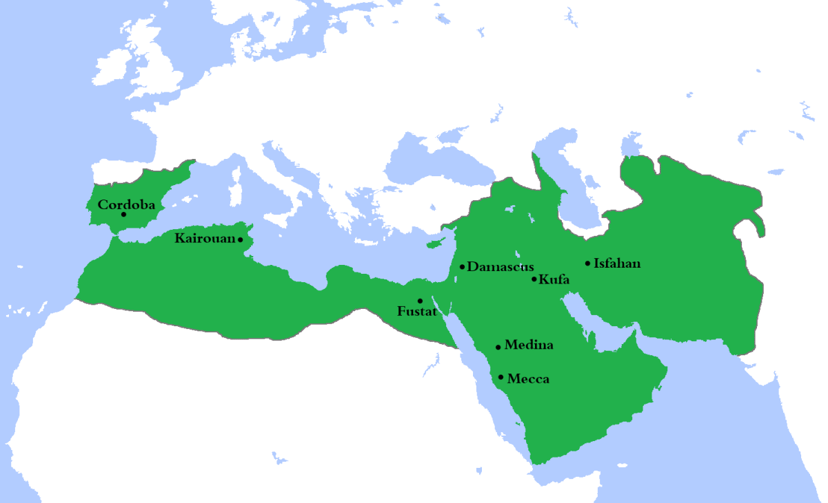
Umayyad Caliphate

Umayyad Caliphate اَلْخِلافَةُ ٱلأُمَوِيَّة | |||||||||||||||||||||||||||||||
|---|---|---|---|---|---|---|---|---|---|---|---|---|---|---|---|---|---|---|---|---|---|---|---|---|---|---|---|---|---|---|---|
| 661–750 | |||||||||||||||||||||||||||||||
| Capital |
| ||||||||||||||||||||||||||||||
| Capital-in-exile | Córdoba (756–1031) | ||||||||||||||||||||||||||||||
| Common languages | Classical Arabic (official) – Coptic, Greek, Latin, Persian (official in certain regions until the reign of Abd al-Malik) – Aramaic, Armenian, Berber languages, African Romance, Mozarabic, Sindhi, Georgian, Prakrit | ||||||||||||||||||||||||||||||
| Religion | Sunni Islam | ||||||||||||||||||||||||||||||
| Government | Caliphate | ||||||||||||||||||||||||||||||
| Caliph | |||||||||||||||||||||||||||||||
• 661–680 | Muawiya I (first) | ||||||||||||||||||||||||||||||
• 744-750 | Marwan II (last) | ||||||||||||||||||||||||||||||
| History | |||||||||||||||||||||||||||||||
• Muawiya I becomes Caliph | estimated from 660 to 665 | ||||||||||||||||||||||||||||||
• Defeat and death of Marwan II by the Abbasids | 750 | ||||||||||||||||||||||||||||||
| Area | |||||||||||||||||||||||||||||||
| 720 | 11,100,000[1] km2(4,300,000 sq mi) | ||||||||||||||||||||||||||||||
| Population | |||||||||||||||||||||||||||||||
• 724 | 33,000,000[2] | ||||||||||||||||||||||||||||||
| Currency | Gold dinar and dirham | ||||||||||||||||||||||||||||||
| |||||||||||||||||||||||||||||||
The Umayyad Caliphate (661–750 CE; UK: /ʊˈmaɪjæd, uːˈ-/,[3] US: /uːˈmaɪ(j)əd, -aɪæd/;[4][5][6] Arabic: اَلْخِلافَةُ ٱلأُمَوِيَّة, romanized: al-Khilāfatu l-ʾUmawiyyah)[7] was the second of the four major caliphates established after the death of Muhammad. The caliphate was ruled by the Umayyad dynasty (Arabic: اَلأُمَوِيُّون, al-ʾUmawiyyūn, or بَنُو أُمَيَّة, Banū ʾUmayya, "Sons of Umayya"), hailing from Mecca. The third Caliph, Uthman ibn Affan (r. 644–656), was a member of the Umayyad clan. The family established dynastic, hereditary rule with Muawiya ibn Abi Sufyan, long-time governor of Syria, who became the sixth Caliph after the end of the First Muslim Civil War in 661. After Mu'awiyah's death in 680, conflicts over the succession resulted in a Second Civil War[8] and power eventually fell into the hands of Marwan I from another branch of the clan. Syria remained the Umayyads' main power base thereafter, and Damascus was their capital.
The Umayyads continued the Muslim conquests, incorporating the Transoxiana, Sindh, the Maghreb and the Iberian Peninsula (Al-Andalus) into the Muslim world. At its greatest extent, the Umayyad Caliphate covered 11,100,000 km2 (4,300,000 sq mi)[1] and 33 million people,[2] making it one of the largest empires in history in both area and proportion of the world's population. The dynasty was eventually overthrown by a rebellion led by the Abbasids in 750. Survivors of the dynasty established themselves in Cordoba in the form of an Emirate and then a Caliphate, lasting until 1031.
The Umayyad caliphate ruled over a vast multiethnic and multicultural population. Christians, who still constituted a majority of the Caliphate's population, and Jews were allowed to practice their own religion but had to pay a head tax (the jizya) from which Muslims were exempt.[9] There was, however, the Muslim-only zakat tax, which was earmarked explicitly for various welfare progammes.[9][10] Prominent positions were held by Christians, some of whom belonged to families that had served in Byzantine governments. The employment of Christians was part of a broader policy of religious accommodation that was necessitated by the presence of large Christian populations in the conquered provinces, as in Syria. This policy also boosted Muawiya's popularity and solidified Syria as his power base.[11][12]
Umayyad Caliphate اَلْخِلافَةُ ٱلأُمَوِيَّة | |||||||||||||||||||||||||||||||
|---|---|---|---|---|---|---|---|---|---|---|---|---|---|---|---|---|---|---|---|---|---|---|---|---|---|---|---|---|---|---|---|
| 661–750 | |||||||||||||||||||||||||||||||
| Capital |
| ||||||||||||||||||||||||||||||
| Capital-in-exile | Córdoba (756–1031) | ||||||||||||||||||||||||||||||
| Common languages | Classical Arabic (official) – Coptic, Greek, Latin, Persian (official in certain regions until the reign of Abd al-Malik) – Aramaic, Armenian, Berber languages, African Romance, Mozarabic, Sindhi, Georgian, Prakrit | ||||||||||||||||||||||||||||||
| Religion | Sunni Islam | ||||||||||||||||||||||||||||||
| Government | Caliphate | ||||||||||||||||||||||||||||||
| Caliph | |||||||||||||||||||||||||||||||
• 661–680 | Muawiya I (first) | ||||||||||||||||||||||||||||||
• 744-750 | Marwan II (last) | ||||||||||||||||||||||||||||||
| History | |||||||||||||||||||||||||||||||
• Muawiya I becomes Caliph | estimated from 660 to 665 | ||||||||||||||||||||||||||||||
• Defeat and death of Marwan II by the Abbasids | 750 | ||||||||||||||||||||||||||||||
| Area | |||||||||||||||||||||||||||||||
| 720 | 11,100,000[1] km2(4,300,000 sq mi) | ||||||||||||||||||||||||||||||
| Population | |||||||||||||||||||||||||||||||
• 724 | 33,000,000[2] | ||||||||||||||||||||||||||||||
| Currency | Gold dinar and dirham | ||||||||||||||||||||||||||||||
| |||||||||||||||||||||||||||||||
History
Origins
Early influence
In the decades preceding the advent of Islam in the early 7th century, the Umayyads or "Banu Umayya" were a leading clan of the Quraysh in Mecca.[13] By the end of the 6th century, the Umayyads dominated the Quraysh's increasingly prosperous trade networks with Syria in the north and Yemen in the south.[14] In the process, they developed economic and military alliances with the nomadic Arab tribes that controlled the northern and central Arabian desert expanses that their caravans traversed, allowing them a degree of political power in the region.[14] The Umayyads under the leadership of Abu Sufyan ibn Harb were the principal leaders of Meccan opposition to the Islamic prophet Muhammad, but after the latter captured Mecca in 630, Abu Sufyan and the Quraysh embraced Islam.[15][16] To reconcile his influential Qurayshi tribesmen, Muhammad gave his former opponents, including Abu Sufyan, a stake in the new order.[17][18][19] Abu Sufyan and the Umayyads relocated to Medina, Islam's political center, to maintain their new-found political influence in the nascent Muslim community.[20]
Following Muhammad's death in 632, a succession crisis ensued and nomadic tribes throughout Arabia that had embraced Islam defected from the Medina-based Muslim state.[21] Abu Bakr, trusted by the Ansar and the Muhajirun (Muhammad's earliest supporters from Medina and Mecca, respectively) as one of Muhammad's closest friends and accepted by the late converts from the Quraysh as a native Meccan who assured their influential role in state matters, was chosen as caliph (political and religious leader of the Muslim community).[22] Abu Bakr showed favor to the Umayyads by awarding them command roles in the Muslim conquest of Syria. One of the appointees was Yazid, the son of Abu Sufyan who owned property and maintained trade networks in Syria.[23][24]
Abu Bakr's successor, Caliph Umar (r. 634–644), though he actively curtailed the influence of the Qurayshi elite in favor of Muhammad's earlier supporters in the administration and military, did not disturb the growing foothold of Abu Sufyan's sons in Syria, which was all but conquered by 638.[25] When his overall commander over the province, Abu Ubayda ibn al-Jarrah, died in 639, he appointed Yazid governor of its Damascus, Palestine and Jordan districts.[25] Yazid died shortly after and Umar installed his brother Mu'awiya in his place.[26] Umar's exceptional treatment of Abu Sufyan's sons may have stemmed from his respect for the family, their burgeoning alliance with the powerful Banu Kalb tribe as a counterbalance to the influence of the Himyarite tribes in the Homs district or the lack of a suitable candidate at the time, particularly amid the plague of Amwas which had already killed Abu Ubayda and Yazid.[26] Under Mu'awiya's stewardship, Syria remained domestically peaceful, organized and well-defended from its former Byzantine rulers.[27]
Caliphate of Uthman
Umar's successor, Uthman ibn Affan, was a wealthy Umayyad and early Muslim convert with marital ties to Muhammad.[28] He was elected by the shura council, composed of Muhammad's cousin Ali, al-Zubayr ibn al-Awwam, Talha ibn Ubayd Allah, Sa'd ibn Abi Waqqas and Abd al-Rahman ibn Awf, all of whom were close, early companions of Muhammad and belonged to the Quraysh.[28][29] He was chosen over Ali because he would ensure the concentration of state power into the hands of the Quraysh, as opposed to Ali's determination to diffuse power among all of the Muslim factions.[30] From early in his reign, he displayed explicit favoritism to his kinsmen, in stark contrast to his predecessors.[28][29] He appointed his family members as governors over the regions successively conquered under Umar and himself, namely much of the Sasanian Empire, i.e. Iraq and Iran, and the former Byzantine territories of Syria and Egypt.[29] In Medina, he relied extensively on the counsel of his Umayyad cousins, the brothers al-Harith and Marwan ibn al-Hakam.[31] According to the historian Wilferd Madelung, this policy stemmed from Uthman's "conviction that the house of Umayya, as the core clan of Quraysh, was uniquely qualified to rule in the name of Islam".[28]
Uthman's nepotism gained him the ire of the Ansar and the members of the shura.[28][29] In 645/46, he added the Jazira (Upper Mesopotamia) to Mu'awiya's Syrian governorship and granted the latter's request to take possession of all Byzantine crown lands in Syria to help pay his troops.[32] He forwarded the surplus taxes from the wealthy provinces of Kufa and Egypt to the treasury in Medina, which he used at his personal disposal, frequently disbursing its funds and war booty to his Umayyad relatives.[33] Moreover, the lucrative Sasanian crown lands of Iraq, which Umar had designated as communal property for the benefit of the Arab garrison towns of Kufa and Basra, were turned into caliphal crown lands to be used at Uthman's discretion.[34] Mounting resentment against Uthman's rule in Iraq and Egypt and among the Ansar and Quraysh of Medina culminated in the siege and killing of the caliph in 656. In the assessment of the historian Hugh N. Kennedy, Uthman was killed because of his determination to centralize control over the Caliphate's government by the traditional elite of the Quraysh, particularly his Umayyad clan, which he believed possessed the "experience and ability" to govern, at the expense of the interests, rights and privileges of many early Muslims.[31]
First Fitna
In the aftermath of Uthman's assassination, Ali was recognized as caliph in Medina, though his support stemmed from the Ansar and the Iraqis, while the bulk of the Quraysh were wary of his rule.[31][35] Indeed, the first challenge to his authority came from the Qurayshi leaders al-Zubayr and Talha, who, though opposed to Uthman's empowerment of the Umayyad clan, feared that their own influence and the power of the Quraysh in general would dissipate under Ali.[36][37] Backed by one of Muhammad's wives, A'isha, they attempted to rally support against Ali among the troops of Basra, prompting the caliph to leave for Iraq's other garrison town, Kufa, where he could better confront his challengers.[38] Ali defeated them at the Battle of the Camel, in which al-Zubayr and Talha were slain and A'isha consequently entered self-imposed seclusion.[38][39] Ali's sovereignty was thereafter recognized in Basra and Egypt and he established Kufa as the Caliphate's new capital.[39]
Though Ali was able to replace Uthman's governors in Egypt and Iraq with relative ease, Mu'awiya had developed a solid power-base and an effective military against the Byzantines from the Arab tribes of Syria, which he governed since Umar's reign.[38] Mu'awiya did not claim the caliphate, but was determined to retain control of Syria and opposed Ali in the name of avenging his kinsman Uthman, accusing the caliph of culpability in his death.[40][41][42] Following his victory in Basra, Ali marched against Mu'awiya, the two sides meeting at the Euphrates river boundary separating their territories. The two sides fought to a stalemate in the ensuing Battle of Siffin in early 657, and Ali was compelled to settle the matter with Mu'awiya by arbitration, though the talks failed to achieve a resolution.[43]
The decision to arbitrate fundamentally weakened Ali's political position as he was forced to negotiate with Mu'awiya on equal terms, while it drove a significant number of his most pious supporters, who became known as the Kharijites, to revolt.[44] Ali's coalition steadily disintegrated and many Iraqi tribal nobles secretly defected to Mu'awiya, while the latter's ally Amr ibn al-As ousted Ali's governor from Egypt in July 658, dealing a blow to the caliph's influence.[43][45] In July 660, Mu'awiya was formally recognized as caliph in Jerusalem by his Syrian tribal allies.[43] Ali's attempt to once again march against Mu'awiya was aborted as a result of Ali's assassination by a Kharijite in January 661.[46] His son al-Hasan succeeded him, but abdicated in return for compensation upon Mu'awiya's arrival to Iraq with his Syrian army in the summer.[43] At that point, Mu'awiya entered Kufa and received the allegiance of the Iraqis.[47]
Sufyanids
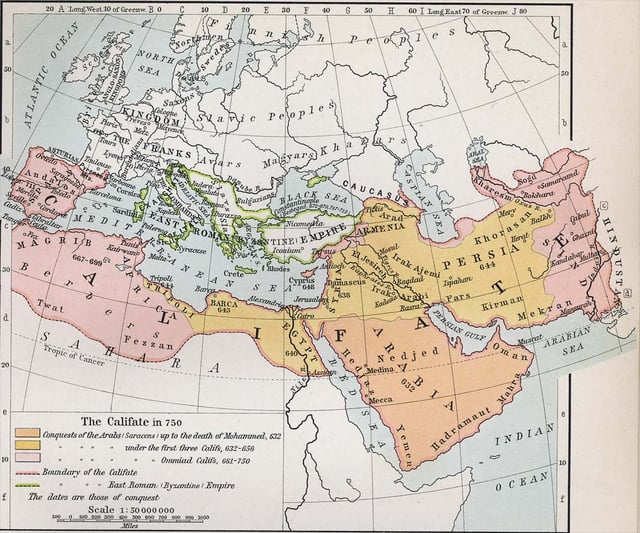
The expansion of the Muslim Caliphate until 750, from William R. Shepherd's Historical Atlas. Muslim state at the death of Muhammad Expansion under the Rashidun Caliphate Expansion under the Umayyad Caliphate Byzantine Empire
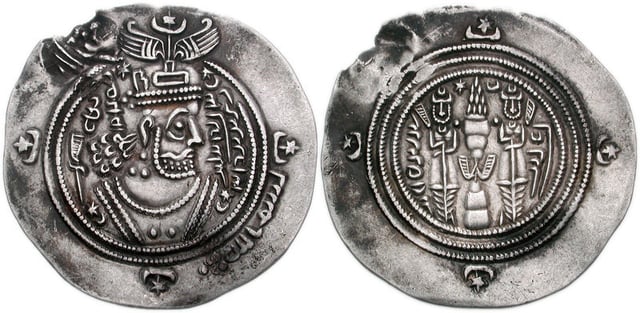
Umayyad Caliphate coin imitating the coinage of Sasanid Empire ruler Khosrau II. Coin of the time of Mu'awiya I ibn Abi Sufyan (Muawiyah I). BCRA (Basra) mint; "Ubayd Allah ibn Ziyad, governor". Dated AH 56 = AD 675/6. Sasanian style bust imitating Khosrau II right; bismillah and three pellets in margin; c/m: winged creature right / Fire altar with ribbons and attendants; star and crescent flanking flames; date to left, mint name to right.
Muawiyah's personal dynasty, the "Sufyanids" (descendants of Abu Sufyan), reigned from 661 to 684, until his grandson Muawiya II. The reign of Muawiyah I was marked by internal security and external expansion. On the internal front, only one major rebellion is recorded, that of Hujr ibn Adi in Kufa. Hujr ibn Adi supported the claims of the descendants of Ali to the caliphate, but his movement was easily suppressed by the governor of Iraq, Ziyad ibn Abi Sufyan. Hujr, who had been a sahabah (companion of Muhammad), was sentenced to death by Muawiya for his support of Ali.[48]
Muawiyah also encouraged peaceful coexistence with the Christian communities of Syria, granting his reign with "peace and prosperity for Christians and Arabs alike",[49] and one of his closest advisers was Sarjun ibn Mansur, the father of John of Damascus. At the same time, he waged unceasing war against the Byzantine Roman Empire. During his reign, Rhodes and Crete were occupied, and several assaults were launched against Constantinople. After their failure, and faced with a large-scale Christian uprising in the form of the Mardaites, Muawiyah concluded a peace with Byzantium. Muawiyah also oversaw military expansion in North Africa (the foundation of Kairouan) and in Central Asia (the conquest of Kabul, Bukhara, and Samarkand).
Muawiyah was succeeded by his son, Yazid I, in 680. This hereditary accession was opposed by a number of prominent Muslims, most notably Abd-Allah ibn al-Zubayr, son of a companion of Muhammad, and Husayn ibn Ali, the younger son of Ali. The resulting conflict is known as the Second Fitna.[8] Ibn al-Zubayr had fled Medina for Mecca, where he remained in opposition until his death. The people of Kufa invited Husayn to their city and revolt against the Umayyads. However, Yazid I prevented this alliance by having Kufa occupied[50] and Husayn and his family intercepted on their way to Kufa in the Battle of Karbala, in which Husayn and his male family members were killed.[50] Word of Husayn's death fueled further opposition movements, one centered in Medina and the other around Kharijites in Basra. In 683, Yazid's army suppressed the Medinese opposition at the Battle of al-Harrah and then besieged Mecca. During the campaign, widespread pillaging and the damaging of both the Grand Mosque in Medina and the Kaaba in Mecca caused deep resentment and became a major cause for censure of the Umayyads in later histories of the period.
Yazid died while the siege was still in progress, and the Umayyad army returned to Damascus, leaving Ibn al-Zubayr in control of Mecca. Yazid's son, Muawiya II (683–684), initially succeeded him but seems to have never been recognized as caliph outside of Syria. Two factions developed within Syria: the Confederation of Qays, who supported Ibn al-Zubayr, and the Quda'a, who supported Marwan, a descendant of Umayya via Wa'il ibn Umayyah. The partisans of Marwan triumphed at a battle at Marj Rahit, near Damascus, in 684, and Marwan became Caliph shortly thereafter.
First Marwanids
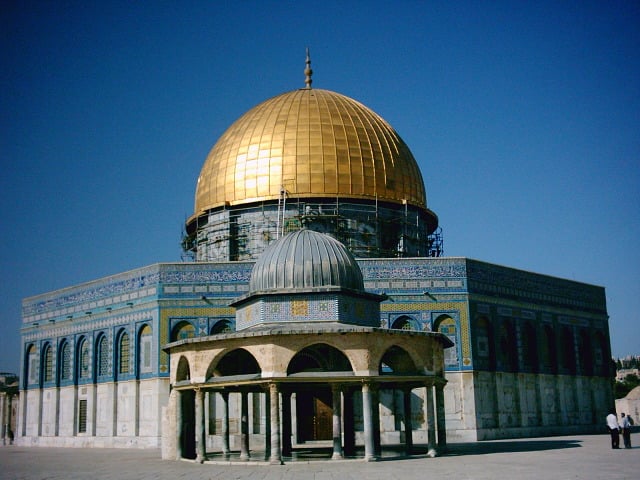
The Dome of the Rock in Jerusalem
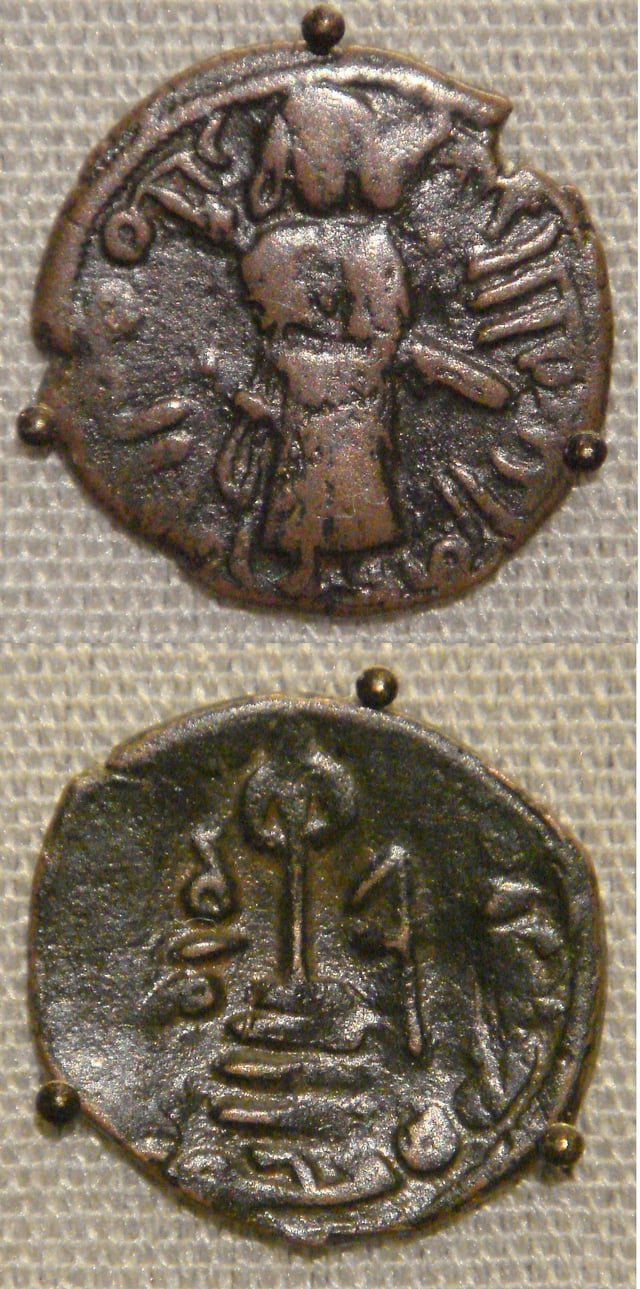
Two coins of the Umayyad Caliphate, based on Byzantine prototypes. Copper falus, Aleppo, Syria, circa 695
Marwan's first task was to assert his authority against the rival claims of Ibn al-Zubayr, who was at this time recognized as caliph throughout most of the Islamic world. Marwan recaptured Egypt for the Umayyads, but died in 685, having reigned for only nine months.
Marwan was succeeded by his son, Abd al-Malik (685–705), who reconsolidated Umayyad control of the caliphate. The early reign of Abd al-Malik was marked by the revolt of Al-Mukhtar, which was based in Kufa. Al-Mukhtar hoped to elevate Muhammad ibn al-Hanafiyyah, another son of Ali, to the caliphate, although Ibn al-Hanafiyyah himself may have had no connection to the revolt. The troops of al-Mukhtar engaged in battles both with the Umayyads in 686, defeating them at the river Khazir near Mosul, and with Ibn al-Zubayr in 687, at which time the revolt of al-Mukhtar was crushed. In 691, Umayyad troops reconquered Iraq, and in 692 the same army captured Mecca. Ibn al-Zubayr was killed in the attack.
The second major event of the early reign of Abd al-Malik was the construction of the Dome of the Rock in Jerusalem. Although the chronology remains somewhat uncertain, the building seems to have been completed in 692, which means that it was under construction during the conflict with Ibn al-Zubayr. This had led some historians, both medieval and modern, to suggest that the Dome of the Rock was built as a destination for pilgrimage to rival the Kaaba, which was under the control of Ibn al-Zubayr.
Abd al-Malik is credited with centralizing the administration of the Caliphate and with establishing Arabic as its official language. He also introduced a uniquely Muslim coinage, marked by its aniconic decoration, which supplanted the Byzantine and Sasanian coins that had previously been in use. Abd al-Malik also recommenced offensive warfare against Byzantium, defeating the Byzantines at Sebastopolis and recovering control over Armenia and Caucasian Iberia.
Following Abd al-Malik's death, his son, Al-Walid I (705–715), became caliph. Al-Walid was also active as a builder, sponsoring the construction of Al-Masjid al-Nabawi in Medina and the Great Mosque of Damascus.
In the year 712, Muhammad bin Qasim, an Umayyad general, sailed from the Persian Gulf into Sindh and conquered both the Sindh and the Punjab regions along the Indus river. The conquest of Sindh and Punjab, in modern-day Pakistan, although costly, were major gains for the Umayyad Caliphate. However, further gains were halted by the death of Al-Hajjaj bin Yusuf Al-Thaqafi, as after his death Muhammad was called back from his conquests. After this, Muslim chroniclers admit that the Caliph Mahdi "gave up the project of conquering any part of India".
A major figure during the reigns of both al-Walid and Abd al-Malik was the Umayyad governor of Iraq, Al-Hajjaj bin Yousef. Many Iraqis remained resistant to Umayyad rule, and to maintain order al-Hajjaj imported Syrian troops, which he housed in a new garrison town, Wasit. These troops became crucial in the suppression of a revolt led by an Iraqi general, Ibn al-Ash'ath, in the early eighth century.
Al-Walid was succeeded by his brother, Sulayman (715–717), whose reign was dominated by a protracted siege of Constantinople. The failure of the siege marked the end of serious Arab ambitions against the Byzantine capital. However, the first two decades of the eighth century witnessed the continuing expansion of the Caliphate, which pushed into the Iberian Peninsula in the west, and into Transoxiana in the Muslim conquest of Transoxiana (under Qutayba ibn Muslim) and northern India in the east.
In AD 715, the Umayyad Caliphate deposed the ikhshid of the Principality of Farghana, and installed a new king Alutar on the throne. The deposed king fled to Kucha (seat of Anxi Protectorate), and sought Chinese intervention. The Tang dynasty sent 10,000 troops under Zhang Xiaosong to Ferghana. He defeated Alutar and the Arab occupation force at Namangan and reinstalled the ikhshid on the throne.[55]
Sulayman was succeeded by his cousin, Umar ibn Abd al-Aziz (717–720), whose position among the Umayyad caliphs is somewhat unusual. He is the only Umayyad ruler to have been recognized by subsequent Islamic tradition as a genuine caliph (khalifa) and not merely as a worldly king (malik).
Umar is honored for his attempt to resolve the fiscal problems attendant upon conversion to Islam. During the Umayyad period, the majority of people living within the caliphate were not Muslim, but Christian, Jewish, Zoroastrian, or members of other small groups. These religious communities were not forced to convert to Islam, but were subject to a tax (jizyah) which was not imposed upon Muslims. This situation may actually have made widespread conversion to Islam undesirable from the point of view of state revenue, and there are reports that provincial governors actively discouraged such conversions. It is not clear how Umar attempted to resolve this situation, but the sources portray him as having insisted on like treatment of Arab and non-Arab (mawali) Muslims, and on the removal of obstacles to the conversion of non-Arabs to Islam.
After the death of Umar, another son of Abd al-Malik, Yazid II (720–724) became caliph. Yazid is best known for his "iconoclastic edict", which ordered the destruction of Christian images within the territory of the Caliphate. In 720, another major revolt arose in Iraq, this time led by Yazid ibn al-Muhallab.
Hisham and the limits of military expansion

The North gate of the city of Resafa, site of Hisham's palace and court
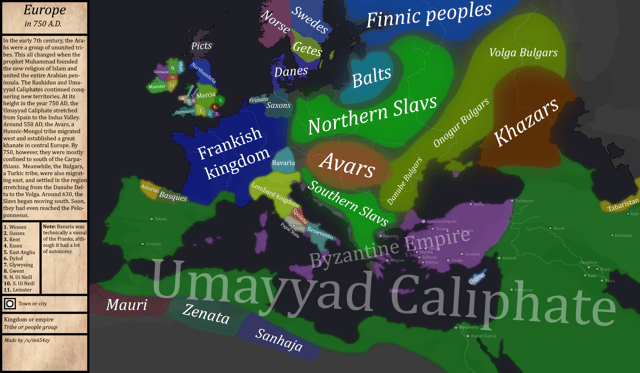
The Umayyad Caliphate at its greatest extent in AD 750
The final son of Abd al-Malik to become caliph was Hisham (724–43), whose long and eventful reign was above all marked by the curtailment of military expansion. Hisham established his court at Resafa in northern Syria, which was closer to the Byzantine border than Damascus, and resumed hostilities against the Byzantines, which had lapsed following the failure of the last siege of Constantinople. The new campaigns resulted in a number of successful raids into Anatolia, but also in a major defeat (the Battle of Akroinon), and did not lead to any significant territorial expansion.
From the caliphate's north-western African bases, a series of raids on coastal areas of the Visigothic Kingdom paved the way to the permanent occupation of most of Iberia by the Umayyads (starting in 711), and on into south-eastern Gaul (last stronghold at Narbonne in 759). Hisham's reign witnessed the end of expansion in the west, following the defeat of the Arab army by the Franks at the Battle of Tours in 732. In 739 a major Berber Revolt broke out in North Africa, which was probably the largest military setback in the reign of Caliph Hisham. From it, emerged some of the first Muslim states outside the Caliphate. It is also regarded as the beginning of Moroccan independence, as Morocco would never again come under the rule of an eastern Caliph or any other foreign power until the 20th century. It was followed by the collapse of Umayyad authority in al-Andalus. In India the Arab armies were defeated by the south Indian Chalukya dynasty and by the north Indian Pratiharas Dynasty in the 8th century and the Arabs were driven out of India.[58][59][60]
In the Caucasus, the confrontation with the Khazars peaked under Hisham: the Arabs established Derbent as a major military base and launched several invasions of the northern Caucasus, but failed to subdue the nomadic Khazars. The conflict was arduous and bloody, and the Arab army even suffered a major defeat at the Battle of Marj Ardabil in 730. Marwan ibn Muhammad, the future Marwan II, finally ended the war in 737 with a massive invasion that is reported to have reached as far as the Volga, but the Khazars remained unsubdued.
Hisham suffered still worse defeats in the east, where his armies attempted to subdue both Tokharistan, with its center at Balkh, and Transoxiana, with its center at Samarkand. Both areas had already been partially conquered, but remained difficult to govern. Once again, a particular difficulty concerned the question of the conversion of non-Arabs, especially the Sogdians of Transoxiana. Following the Umayyad defeat in the "Day of Thirst" in 724, Ashras ibn 'Abd Allah al-Sulami, governor of Khurasan, promised tax relief to those Sogdians who converted to Islam, but went back on his offer when it proved too popular and threatened to reduce tax revenues.
Discontent among the Khurasani Arabs rose sharply after the losses suffered in the Battle of the Defile in 731. In 734, al-Harith ibn Surayj led a revolt that received broad backing from Arabs and natives alike, capturing Balkh but failing to take Merv. After this defeat, al-Harith's movement seems to have been dissolved. The problem of the rights of non-Arab Muslims would continue to plague the Umayyads.
Third Fitna
Hisham was succeeded by Al-Walid II (743–44), the son of Yazid II. Al-Walid is reported to have been more interested in earthly pleasures than in religion, a reputation that may be confirmed by the decoration of the so-called "desert palaces" (including Qusayr Amra and Khirbat al-Mafjar) that have been attributed to him. He quickly attracted the enmity of many, both by executing a number of those who had opposed his accession, and by persecuting the Qadariyya.
In 744, Yazid III, a son of al-Walid I, was proclaimed caliph in Damascus, and his army tracked down and killed al-Walid II. Yazid III has received a certain reputation for piety, and may have been sympathetic to the Qadariyya. He died a mere six months into his reign.
Yazid had appointed his brother, Ibrahim, as his successor, but Marwan II (744–50), the grandson of Marwan I, led an army from the northern frontier and entered Damascus in December 744, where he was proclaimed caliph. Marwan immediately moved the capital north to Harran, in present-day Turkey. A rebellion soon broke out in Syria, perhaps due to resentment over the relocation of the capital, and in 746 Marwan razed the walls of Homs and Damascus in retaliation.
Marwan also faced significant opposition from Kharijites in Iraq and Iran, who put forth first Dahhak ibn Qays and then Abu Dulaf as rival caliphs. In 747, Marwan managed to reestablish control of Iraq, but by this time a more serious threat had arisen in Khorasan.
Abbasid Revolution
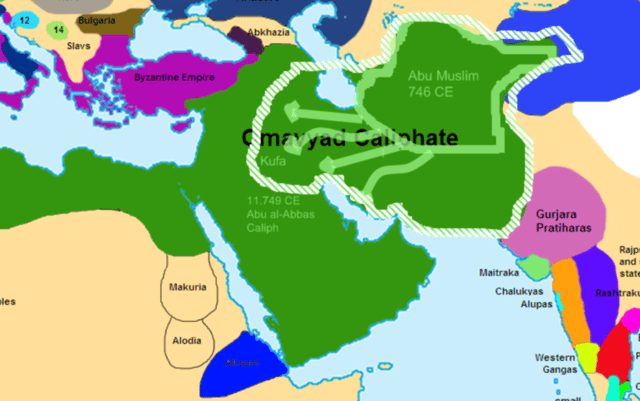
The Caliphate at the beginning of the Abbasid revolt, before the Battle of the Zab
The Hashimiyya movement (a sub-sect of the Kaysanites Shia), led by the Abbasid family, overthrew the Umayyad caliphate. The Abbasids were members of the Hashim clan, rivals of the Umayyads, but the word "Hashimiyya" seems to refer specifically to Abu Hashim, a grandson of Ali and son of Muhammad ibn al-Hanafiyya. According to certain traditions, Abu Hashim died in 717 in Humeima in the house of Muhammad ibn Ali, the head of the Abbasid family, and before dying named Muhammad ibn Ali as his successor. This tradition allowed the Abbasids to rally the supporters of the failed revolt of Mukhtar, who had represented themselves as the supporters of Muhammad ibn al-Hanafiyya.
Beginning around 719, Hashimiyya missions began to seek adherents in Khurasan. Their campaign was framed as one of proselytism (dawah). They sought support for a "member of the family" of Muhammad, without making explicit mention of the Abbasids. These missions met with success both among Arabs and non-Arabs (mawali), although the latter may have played a particularly important role in the growth of the movement.
Around 746, Abu Muslim assumed leadership of the Hashimiyya in Khurasan. In 747, he successfully initiated an open revolt against Umayyad rule, which was carried out under the sign of the black flag. He soon established control of Khurasan, expelling its Umayyad governor, Nasr ibn Sayyar, and dispatched an army westwards. Kufa fell to the Hashimiyya in 749, the last Umayyad stronghold in Iraq, Wasit, was placed under siege, and in November of the same year Abul Abbas as-Saffah was recognized as the new caliph in the mosque at Kufa. At this point Marwan mobilized his troops from Harran and advanced toward Iraq. In January 750 the two forces met in the Battle of the Zab, and the Umayyads were defeated. Damascus fell to the Abbasids in April, and in August, Marwan was killed in Egypt.
The victors desecrated the tombs of the Umayyads in Syria, sparing only that of Umar II, and most of the remaining members of the Umayyad family were tracked down and killed. When Abbasids declared amnesty for members of the Umayyad family, eighty gathered to receive pardons, and all were massacred. One grandson of Hisham, Abd al-Rahman I, survived, escaped across North Africa, and established an emirate in Moorish Iberia (Al-Andalus). In a claim unrecognized outside of al-Andalus, he maintained that the Umayyad Caliphate, the true, authentic caliphate, more legitimate than the Abbasids, was continued through him in Córdoba. It was to survive for centuries.
Previté-Orton argues that the reason for the decline of the Umayyads was the rapid expansion of Islam. During the Umayyad period, mass conversions brought Persians, Berbers, Copts, and Aramaics to Islam. These mawalis (clients) were often better educated and more civilised than their Arab overlords. The new converts, on the basis of equality of all Muslims, transformed the political landscape. Previté-Orton also argues that the feud between Syria and Iraq further weakened the empire.[61]
Umayyad administration
The first four caliphs created a stable administration for the empire, following the practices and administrative institutions of the Byzantine Empire which had ruled the same region previously.[62] These consisted of four main governmental branches: political affairs, military affairs, tax collection, and religious administration. Each of these was further subdivided into more branches, offices, and departments.
Provinces
Geographically, the empire was divided into several provinces, the borders of which changed numerous times during the Umayyad reign. Each province had a governor appointed by the caliph. The governor was in charge of the religious officials, army leaders, police, and civil administrators in his province. Local expenses were paid for by taxes coming from that province, with the remainder each year being sent to the central government in Damascus. As the central power of the Umayyad rulers waned in the later years of the dynasty, some governors neglected to send the extra tax revenue to Damascus and created great personal fortunes.[63]
Government workers
As the empire grew, the number of qualified Arab workers was too small to keep up with the rapid expansion of the empire. Therefore, Muawiya allowed many of the local government workers in conquered provinces to keep their jobs under the new Umayyad government. Thus, much of the local government's work was recorded in Greek, Coptic, and Persian. It was only during the reign of Abd al-Malik that government work began to be regularly recorded in Arabic.[63]
Currency
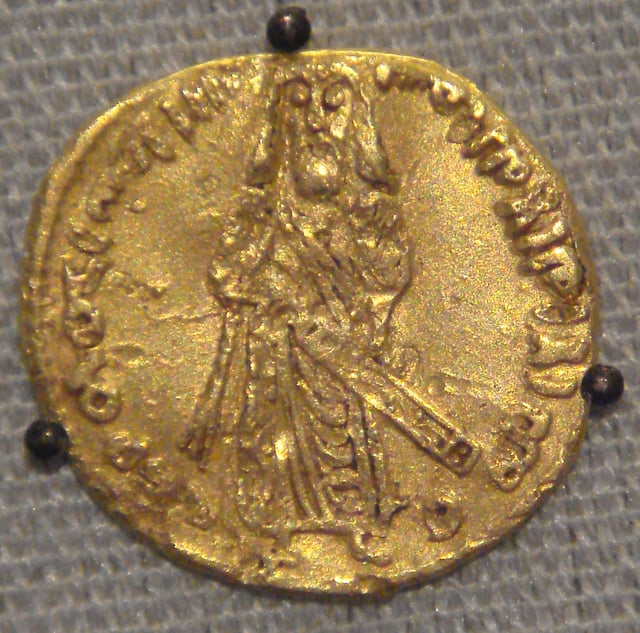
Coin of the Umayyad Caliphate, based on a Byzantine prototype, 695
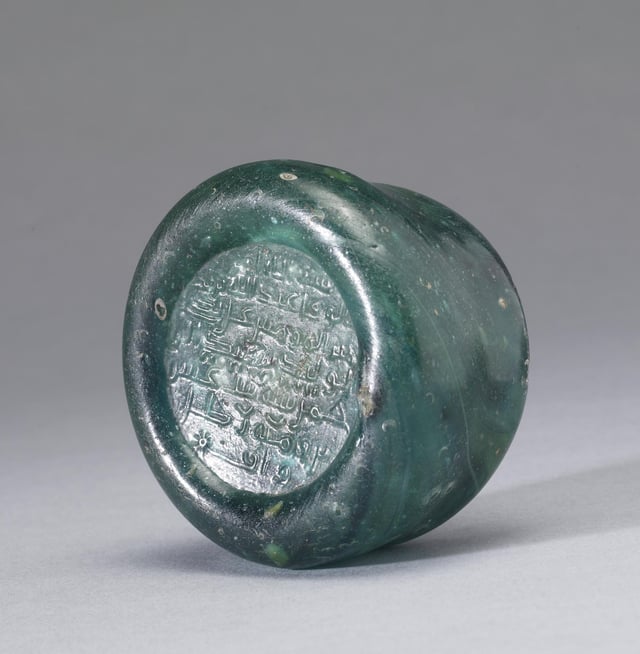
A coin weight from the Umayyad Dynasty, dated 743, made of glass. One of the oldest Islamic objects in an American museum, the Walters Art Museum.
The Byzantine and Sassanid Empires relied on money economies before the Muslim conquest, and that system remained in effect during the Umayyad period. Byzantine copper coins were used until 658, while Byzantine gold coins were still in use until the monetary reforms c.700.[64] In addition to this, the Umayyad government began to mint its own coins in Damascus, which were initially similar to pre-existing coins but evolved in an independent direction. These were the first coins minted by a Muslim government in history. Gold coins were called dinars while silver coins were called dirhams.[63]
Central diwans
To assist the Caliph in administration there were six Boards at the Centre: Diwan al-Kharaj (the Board of Revenue), Diwan al-Rasa'il (the Board of Correspondence), Diwan al-Khatam (the Board of Signet), Diwan al-Barid (the Board of Posts), Diwan al-Qudat (the Board of Justice) and Diwan al-Jund (the Military Board)
Diwan al-Kharaj
The Central Board of Revenue administered the entire finances of the empire. It also imposed and collected taxes and disbursed revenue.
Diwan al-Rasa'il
A regular Board of Correspondence was established under the Umayyads. It issued state missives and circulars to the Central and Provincial Officers. It co-ordinated the work of all Boards and dealt with all correspondence as the chief secretariat.
Diwan al-Khatam
In order to reduce forgery, Diwan al-Khatam (Bureau of Registry), a kind of state chancellery, was instituted by Mu'awiyah. It used to make and preserve a copy of each official document before sealing and despatching the original to its destination. Thus in the course of time a state archive developed in Damascus by the Umayyads under Abd al-Malik. This department survived till the middle of the Abbasid period.
Diwan al-Barid
Mu'awiyah introduced postal service, Abd al-Malik extended it throughout his empire, and Walid made full use of it. Umar bin Abdul-Aziz developed it further by building caravanserais at stages along the Khurasan highway. Relays of horses were used for the conveyance of dispatches between the caliph and his agents and officials posted in the provinces. The main highways were divided into stages of 12 miles (19 km) each and each stage had horses, donkeys or camels ready to carry the post. Primarily the service met the needs of Government officials, but travellers and their important dispatches were also benefitted by the system. The postal carriages were also used for the swift transport of troops. They were able to carry fifty to a hundred men at a time. Under Governor Yusuf bin Umar, the postal department of Iraq cost 4,000,000 dirhams a year.
Diwan al-Qudat
In the early period of Islam, justice was administered by Muhammad and the orthodox Caliphs in person. After the expansion of the Islamic State, Umar al-Faruq had to separate judiciary from the general administration and appointed the first qadi in Egypt as early as AD 643/23 AH. After 661, a series of judges served in Egypt during the caliphates of Hisham and Walid II.
Diwan al-Jund
The Diwan of Umar, assigning annuities to all Arabs and to the Muslim soldiers of other races, underwent a change in the hands of the Umayyads. The Umayyads meddled with the register and the recipients regarded pensions as the subsistence allowance even without being in active service. Hisham reformed it and paid only to those who participated in battle. On the pattern of the Byzantine system the Umayyads reformed their army organization in general and divided it into five corps: the centre, two wings, vanguards and rearguards, following the same formation while on march or on a battle field. Marwan II (740–50) abandoned the old division and introduced the Kurdus (cohort), a small compact body. The Umayyad troops were divided into three divisions: infantry, cavalry and artillery. Arab troops were dressed and armed in Greek fashion. The Umayyad cavalry used plain and round saddles. The artillery used the arradah (ballista), the manjaniq (mangonel) and the dabbabah or kabsh (battering ram). The heavy engines, siege machines and baggage were carried on camels behind the army.
Social organization

Ivory (circa 8th century) discovered in the Abbasid homestead in Humeima, Jordan. The style indicates an origin in northeastern Iran, the base of Hashimiyya military power.[65]
The Umayyad Caliphate had four main social classes:
Muslim Arabs
Muslim non-Arabs (clients of the Muslim Arabs)
Dhimmis, non-Muslim free persons (Christians, Jews, Zoroastrians, and others)
Slaves
The Muslim Arabs were at the top of the society and saw it as their duty to rule over the conquered areas. Despite the fact that Islam teaches the equality of all Muslims, the Arab Muslims held themselves in higher esteem than Muslim non-Arabs and generally did not mix with other Muslims.
As Islam spread, more and more of the Muslim population consisted of non-Arabs. This caused social unrest, as the new converts were not given the same rights as Muslim Arabs. Also, as conversions increased, tax revenues from non-Muslims decreased to dangerous lows. These issues continued to worsen until they helped cause the Abbasid Revolt in the 740s.[66]
Non-Muslims
Non-Muslim groups in the Umayyad Caliphate, which included Christians, Jews, Zoroastrians and pagans, were called dhimmis. They were given a legally protected status as second-class citizens as long as they accepted and acknowledged the political supremacy of the ruling Muslims, i.e. paid a tax, known as jizya, which the Muslims did not have to pay, who would instead pay the zakat tax. If they converted to Islam they would cease paying jizya and would instead pay zakat.
Christians and Jews still continued to produce great theological thinkers within their communities, but as time wore on, many of the intellectuals converted to Islam, leading to a lack of great thinkers in the non-Muslim communities.[67] Important Christian writers from the Umayyad period include the theologian John of Damascus and bishop Cosmas of Maiuma.[68]
Although non-Muslims could not hold the highest public offices in the empire, they held many bureaucratic positions within the government. An important example of Christian employment in the Umayyad government is that of Sarjun ibn Mansur. He was a Melkite Christian official of the early Umayyad Caliphate. The son of a prominent Byzantine official of Damascus, he was a favourite of the early Umayyad caliphs Mu'awiya I and Yazid I, and served as the head of the fiscal administration for Syria from the mid-7th century until the year 700, when Caliph Abd al-Malik ibn Marwan dismissed him as part of his efforts to Arabicize the administration of the Caliphate. According to the Muslim historians al-Baladhuri and al-Tabari, Sanjur was a mawla of the first Umayyad caliph, Mu'awiya I (r. 661–680), [a] serving as his "secretary and the person in charge of his business".[68][70] The hagiographies, although less reliable, also assign to him a role in the administration, even as "ruler" (archon or even amir), of Damascus and its environs, where he was responsible for collecting the revenue.[68] In this capacity, he is attested in later collections of source material such as that of al-Mas'udi.[69] Sarjun ibn Mansur was replaced by Sulayman ibn Sa'd al-Khushani, another Christian.[71]
Muawiya's marriage to Maysun bint Bahdal (Yazid's mother) was politically motivated, as she was the daughter of the chief of the Kalb tribe, which was a large Syriac Orthodox Christian Arab tribe in Syria.[72] The Kalb tribe had remained largely neutral when the Muslims first went into Syria.[73] After the plague that killed much of the Muslim army in Syria, by marrying Maysun, Muawiyah used the Syriac Orthodox Christians against the Byzantines.
Tom Holland writes [74] Christians, Jews, Samaritans and Manichaeans were all treated well by Muawiyah. Muawiyah even restored Edessa's cathedral after it had been toppled by an earthquake.[75] Savagely though Muawiyah prosecuted his wars against the Romans, yet his subjects, no longer trampled by rival armies, no longer divided by hostile watchtowers, knew only peace at last. Justice flourished in his time, and there was great peace in the regions under his control. He allowed everyone to live as they wanted."[74][76]
Legacy
Muawiyah I's family, including his progenitors, Abu Sufyan ibn Harb and his wife Hind bint Utbah, were originally opponents of Islam and particularly of Muhammad until the Conquest of Mecca, but they converted to the religion in 630.
However, many early history books, e.g., The Islamic Conquest of Syria Fatuhusham, by al-Imam al-Waqidi, state that, after their conversion to Islam, Muhammad appointed Muawiyah I's father Abu Sufyan ibn Harb and his brother Yazid ibn Abi Sufyan as army commanders. Muawiyah I, Abu Sufyan ibn Harb, Yazid ibn Abi Sufyan and Hind bint Utbah[77][78][78][79][80][81] fought in the Battle of Yarmouk. The defeat of the Byzantine Emperor Heraclius at the Battle of Yarmouk opened the way for Muslim expansion into Jerusalem and Syria.
In 639, Muawiyah was appointed as the governor of Syria by the second caliph, Umar, after the two previous governors—his brother Yazid ibn Abi Sufyan and, before him, Abu Ubaidah ibn al-Jarrah—died in a plague along with 25,000 other people.[82][83] 'Amr ibn al-'As was sent to take on the Roman Army in Egypt. Umar asked Muawiyah to defend against an anticipated Roman attack.
Muawiyah next set about creating allies. Muawiyah married Maysum, the daughter of the chief of the Kalb tribe, a large Jacobite Christian Arab tribe in Syria. His marriage to Maysum was politically motivated. The Kalb tribe had remained largely neutral when the Muslims first went into Syria.[73] Muawiyah now could use the Jacobite Christians to restore the ranks of the plague-depleted army against the Romans. Muawiya's wife Maysum (Yazid's mother) was also a Jacobite Christian.[72] With limited resources and the Byzantines just over the border, Muawiyah worked in cooperation with the local Christian population. To stop Byzantine harassment from the sea during the Arab-Byzantine Wars, in 649 Muawiyah set up a navy, which was manned by Monophysite Christians, Copts, and Jacobite Syrian Christian sailors and Muslim troops.[84][85]
Muawiya was one of the first to realize the full importance of having a navy; as long as the Byzantine fleet could sail the Mediterranean unopposed, the coastlines of Syria, Palestine and Egypt would never be safe. Muawiyah, along with Adbullah ibn Sa'd, the new governor of Egypt, successfully persuaded Uthman to give them permission to construct a large fleet in the dockyards of Egypt and Syria.[84][85]
Muawiyah I came to power after the death of Ali and established a dynasty.
Historical significance
The Umayyad caliphate was marked both by territorial expansion and by the administrative and cultural problems that such expansion created. Despite some notable exceptions, the Umayyads tended to favor the rights of the old Arab families, and in particular their own, over those of newly converted Muslims (mawali). Therefore, they held to a less universalist conception of Islam than did many of their rivals. As G.R. Hawting has written, "Islam was in fact regarded as the property of the conquering aristocracy."[92]
During the period of the Umayyads, Arabic became the administrative language. State documents and currency were issued in the language. Mass conversions brought a large influx of Muslims to the caliphate. The Umayyads also constructed famous buildings such as the Dome of the Rock at Jerusalem, and the Umayyad Mosque at Damascus.[93]
According to one common view, the Umayyads transformed the caliphate from a religious institution (during the rashidun) to a dynastic one.[93] However, the Umayyad caliphs do seem to have understood themselves as the representatives of God on earth, and to have been responsible for the "definition and elaboration of God's ordinances, or in other words the definition or elaboration of Islamic law."[94]
The Umayyads have met with a largely negative reception from later Islamic historians, who have accused them of promoting a kingship (mulk, a term with connotations of tyranny) instead of a true caliphate (khilafa). In this respect it is notable that the Umayyad caliphs referred to themselves not as khalifat rasul Allah ("successor of the messenger of God", the title preferred by the tradition), but rather as khalifat Allah ("deputy of God"). The distinction seems to indicate that the Umayyads "regarded themselves as God's representatives at the head of the community and saw no need to share their religious power with, or delegate it to, the emergent class of religious scholars."[95] In fact, it was precisely this class of scholars, based largely in Iraq, that was responsible for collecting and recording the traditions that form the primary source material for the history of the Umayyad period. In reconstructing this history, therefore, it is necessary to rely mainly on sources, such as the histories of Tabari and Baladhuri, that were written in the Abbasid court at Baghdad.
Modern Arab nationalism regards the period of the Umayyads as part of the Arab Golden Age which it sought to emulate and restore. This is particularly true of Syrian nationalists and the present-day state of Syria, centered like that of the Umayyads on Damascus.
The Umayyad dynastic color was white, after the banner of Muawiya ibn Abi Sufyan;[96] it is now one of the four Pan-Arab colors which appear in various combinations on the flags of most Arab countries.
Theological opinions concerning the Umayyads
Sunni opinions
Many Muslims criticized the Umayyads for having too many non-Muslim, former Roman administrators in their government, e.g., St. John of Damascus.[97] As the Muslims took over cities, they left the people's political representatives, the Roman tax collectors, and the administrators in office. The taxes to the central government were calculated and negotiated by the people's political representatives. Both the central and local governments were compensated for the services each provided. Many Christian cities used some of the taxes to maintain their churches and run their own organizations. Later, the Umayyads were criticized by some Muslims for not reducing the taxes of the people who converted to Islam.[98]
Later, when Umar ibn Abd al-Aziz came to power, he reduced these taxes. He is therefore praised as one of the greatest Muslim rulers after the four Rightly Guided Caliphs. Imam Abu Muhammad Adbullah ibn Abdul Hakam who lived in 829 and wrote a biography on Umar Ibn Adbul Aziz[99] stated that the reduction in these taxes stimulated the economy and created wealth but it also reduced the government's budget, including, eventually, the defense budget.
The only Umayyad ruler, who is unanimously praised by Sunni sources for his devout piety and justice is Umar ibn Abd al-Aziz. In his efforts to spread Islam, he established liberties for the Mawali by abolishing the jizya tax for converts to Islam. Imam Abu Muhammad Adbullah ibn Abdul Hakam stated that Umar ibn Abd al-Aziz also stopped the personal allowance offered to his relatives, stating that he could only give them an allowance if he gave an allowance to everyone else in the empire. After Umar ibn Abd al-Aziz was poisoned in 720, successive governments tried to reverse Umar ibn Abd al-Aziz's tax policies, but rebellion resulted.
Shi'a opinions
The negative view of the Umayyads held by Shias is briefly expressed in the Shi'a book "Sulh al-Hasan".[100] According to Shia hadiths, which are not considered authentic by Sunnis, Ali described them as the worst Fitna.[101] In Shia sources, the Umayyad Caliphate is widely described as "tyrannical, anti-Islamic and godless".[102][103] Shias point out that the founder of the dynasty, Muawiyah, declared himself a caliph in 657 and went to war against Muhammad's son-in-law and cousin, the ruling caliph Ali, clashing at the Battle of Siffin. Muawiyah also declared his son, Yazid, as his successor in breach of a treaty with Hassan, Muhammad's grandson. Another of Muhammad's grandsons, Husayn ibn Ali, would be killed by Yazid in the Battle of Karbala. Further Shia Imams, such as Muhammad's great-grandson, Ali ibn Husayn Zayn al-Abidin would be killed at the hands of ruling Umayyad caliphs.
Bahá'í opinions
Asked for an explanation of the prophecies in the Book of Revelation (12:3), `Abdu'l-Bahá suggests in Some Answered Questions that the "great red dragon, having seven heads and ten horns, and seven crowns upon his heads,"[104] refers to the Umayyad caliphs who "rose against the religion of Prophet Muhammad and against the reality of Ali".[105][106]
The seven heads of the dragon are symbolic of the seven provinces of the lands dominated by the Umayyads: Damascus, Persia, Arabia, Egypt, Africa, Andalusia, and Transoxiana. The ten horns represent the ten names of the leaders of the Umayyad dynasty: Abu Sufyan, Muawiya, Yazid, Marwan, Abd al-Malik, Walid, Sulayman, Umar, Hisham, and Ibrahim. Some names were re-used, as in the case of Yazid II and Yazid III, which were not accounted for in this interpretation.
Early literature
The book Al Muwatta, by Imam Malik, was written in the early Abbasid period in Medina. It does not contain any anti-Umayyad content because it was more concerned with what the Quran and what Muhammad said and was not a history book on the Umayyads.
Even the earliest pro-Shia accounts of al-Masudi are more balanced. Al-Masudi's Ibn Hisham is the earliest Shia account of Muawiyah. He recounted that Muawiyah spent a great deal of time in prayer, in spite of the burden of managing a large empire.[107]
Az-Zuhri stated that Muawiya led the Hajj Pilgrimage with the people twice during his era as caliph.
Books written in the early Abbasid period like al-Baladhuri's "The Origins of the Islamic State" provide a more accurate and balanced history. Ibn Hisham also wrote about these events.
Much of the anti-Umayyad literature started to appear in the later Abbasid period in Persia.
After killing off most of the Umayyads and destroying the graves of the Umayyad rulers apart from Muawiyah and Umar ibn Adb al-Aziz, the history books written during the later Abbasid period are more anti-Umayyad.[108] The Abbasids justified their rule by saying that their ancestor Abbas ibn Abd al-Muttalib was a cousin of Muhammad.
The books written later in the Abbasid period in Iran are more anti-Umayyad. Iran was Sunni at the time. There was much anti-Arab feeling in Iran after the fall of the Persian empire.[109] This anti-Arab feeling also influenced the books on Islamic history. Al-Tabri was also written in Iran during that period. Al-Tabri was a huge collection, preserving everything the compiler could find for future generations to codify and to judge whether the histories were true or false.
List of Caliphs

Genealogic tree of the Umayyad family. In blue: Caliph Uthman, one of the four Rashidun Caliphs. In green, the Umayyad Caliphs of Damascus. In yellow, the Umayyad emirs of Córdoba. In orange, the Umayyad Caliphs of Córdoba. Abd Al-Rahman III was an emir until 929 when he proclaimed himself Caliph. Muhammad is included (in caps) to show the kinship of the Umayyads with him.
| Caliph | Reign |
|---|---|
| Caliphs of Damascus | |
| Muawiya I ibn Abu Sufyan | 28 July 661 – 27 April 680 |
| Yazid I ibn Muawiyah | 27 April 680 – 11 November 683 |
| Abd Allah ibn al-Zubayr | |
| Muawiya II ibn Yazid | 11 November 683– June 684 |
| Marwan I ibn al-Hakam | June 684– 12 April 685 |
| Abd al-Malik ibn Marwan | 12 April 685 – 8 October 705 |
| al-Walid I ibn Abd al-Malik | 8 October 705 – 23 February 715 |
| Sulayman ibn Abd al-Malik | 23 February 715 – 22 September 717 |
| Umar ibn Abd al-Aziz | 22 September 717 – 4 February 720 |
| Yazid II ibn Abd al-Malik | 4 February 720 – 26 January 724 |
| Hisham ibn Abd al-Malik | 26 January 724 – 6 February 743 |
| al-Walid II ibn Yazid | 6 February 743 – 17 April 744 |
| Yazid III ibn al-Walid | 17 April 744 – 4 October 744 |
| Ibrahim ibn al-Walid | 4 October 744 – 4 December 744 |
| Marwan II ibn Muhammad (ruled from Harran in the Jazira) | 4 December 744 – 25 January 750 |
See also
History of Islam
List of Sunni Muslim dynasties
Umayya ibn Abd Shams
Umayyad family tree